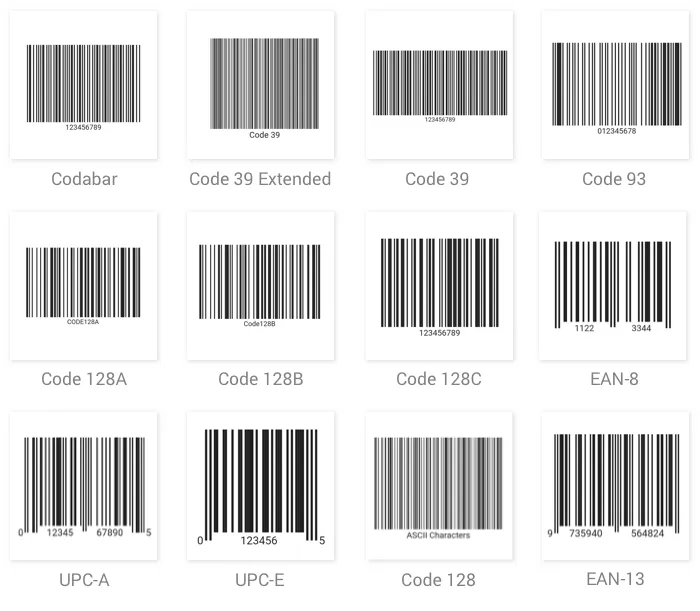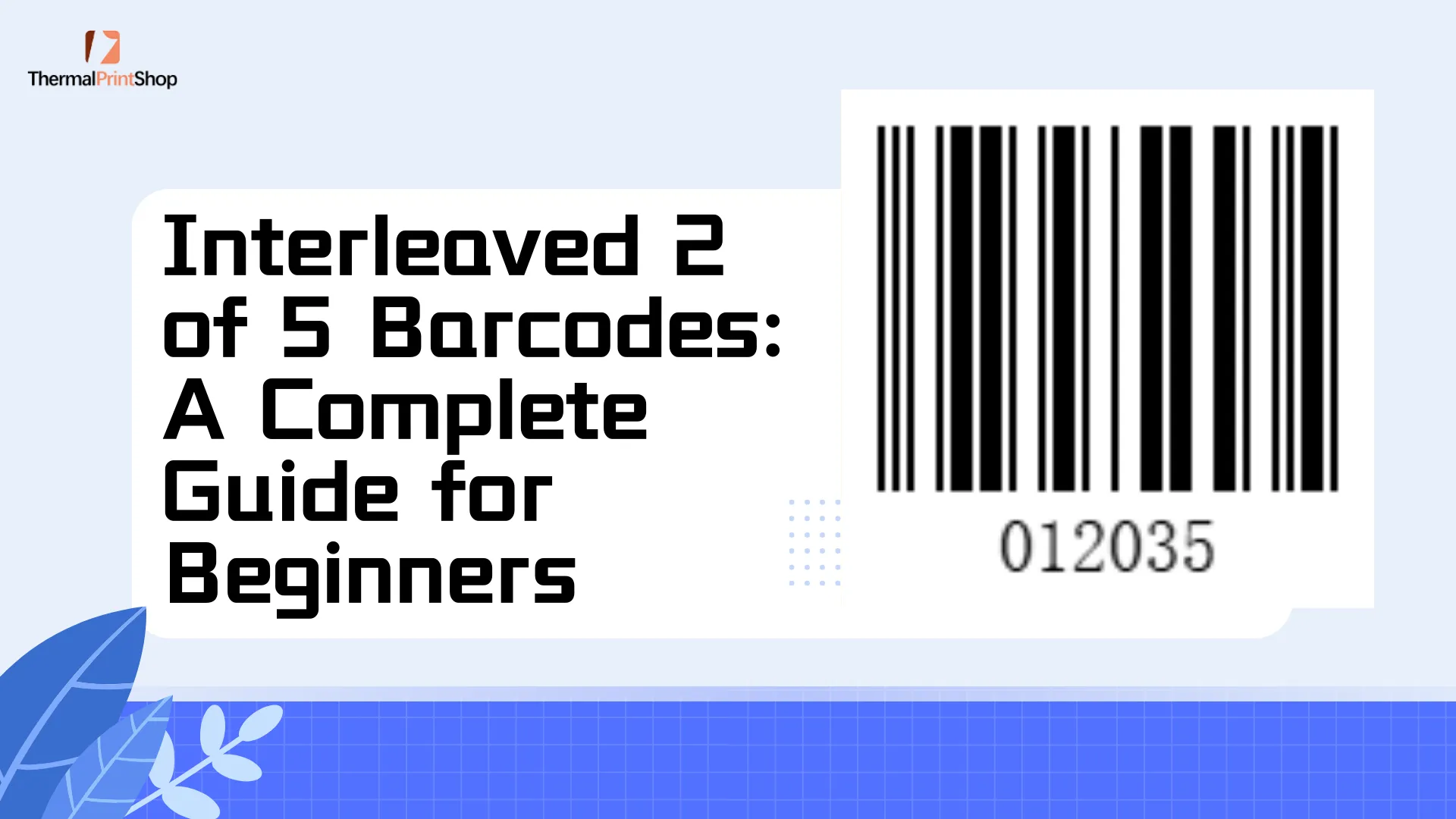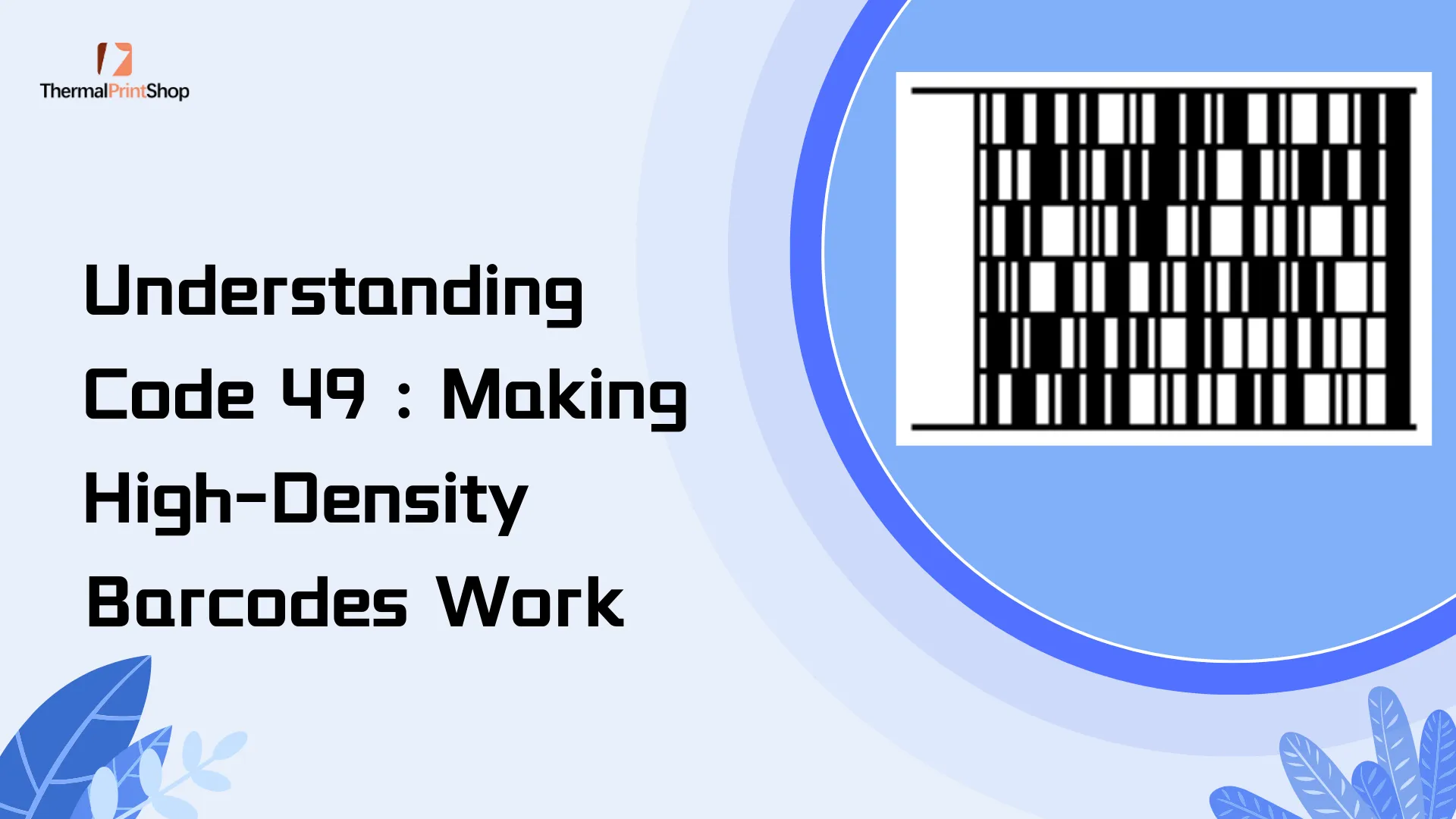Barkodlar modern iş dünyasının bilinmeyen kahramanlarıdır ve sektörler arasında ürünlerin sorunsuz bir şekilde izlenmesini, tanımlanmasını ve yönetilmesini sağlar. İster bir depo yönetiyor, ister bir perakende operasyonunu yürütüyor veya hatta bir kütüphaneyi denetliyor olun, barkodlar temel bilgileri kompakt, makine tarafından okunabilir bir biçimde kodlayarak operasyonları kolaylaştırır. Ancak, bugün mevcut barkod türlerinin çeşitliliği, belirli ihtiyaçlarınız için doğru olanı seçmeyi zorlu bir görev haline getirebilir. Bu kılavuz, barkod türlerinin ayrıntılı bir dökümünü, benzersiz özelliklerini ve uygulamanız için en uygun olanı nasıl seçeceğinizi sağlamayı amaçlamaktadır.
1. Barkod Temellerini Anlamak
Barkodlar, makinelerin okuyabileceği verilerin görsel temsilleridir. Her biri belirli kullanımlar için tasarlanmış çeşitli biçimlerde gelirler. Genel olarak, barkodlar iki kategoriye ayrılır:
1.1 Tek Boyutlu (1D) Barkodlar

1D barkodların bazı tipik örnekleri
1D barkodlar, doğrusal barkodlar olarak da adlandırılır, en tanınan türdür. Bunlar, bilgileri kodlamak için çeşitli genişliklerde bir dizi çizgi ve boşluk kullanır. Ürün kimlikleri veya envanter numaraları gibi küçük miktardaki verileri kodlamak için idealdir.
- UPC (Evrensel Ürün Kodu): Kuzey Amerika'da perakende ürünler için yaygın olarak kullanılan 12 haneli sayısal barkod.
- EAN (Avrupa Makale Numarası): UPC'ye benzer ancak EAN-13 ve EAN-8 gibi versiyonları ile uluslararası kullanıma uyarlanmıştır.
- Kod 39: Hem rakamları hem de harfleri kodlayabildiği için otomotiv ve sağlık gibi sektörlerde çok yönlü kullanıma uygundur.
- Kod 128: Lojistik ve nakliyede daha büyük veri kümelerini kodlamak için kullanılan kompakt, yüksek yoğunluklu bir barkod.
- ITF (5'in 2'si iç içe geçmiş): Ambalaj ve kartonlarda kullanılır, endüstriyel uygulamalar için yeterince sağlamdır.
1.2 İki Boyutlu (2D) Barkodlar

2D barkodların bazı tipik örnekleri
2D barkodlar verileri hem yatay hem de dikey olarak depolar ve bu sayede 1D barkodlardan daha fazla bilgi tutabilirler. Hasara karşı daha dayanıklıdırlar ve hata düzeltme özellikleri içerebilirler, bu da onları daha karmaşık uygulamalar için uygun hale getirir.
- QR Kodu: Pazarlama, URL'ler ve akıllı telefonlar üzerinden hızlı tarama için popülerdir.
- Veri Matrisi: Küçük alanlarda yoğun bilgilerin kodlanması için idealdir, çoğunlukla elektronik ve ilaç sektöründe kullanılır.
- PDF417: Yüksek veri kapasitesi nedeniyle kimliklerde ve ulaşım biletlerinde sıkça görülür.
- Aztek Kodu: Genellikle mobil bilet ve ulaşım uygulamalarında kullanılır.
- MaxiKod: Özellikle UPS gibi taşıyıcılar tarafından nakliye ve lojistik için tasarlanmıştır.
2. Barkod Seçerken Dikkat Edilmesi Gereken Temel Faktörler
Doğru barkod türünü seçmek birkaç faktöre bağlıdır. İşte temel hususlar:
2.1 Barkodun Amacı

Barkoda ne için ihtiyacınız olduğunu belirleyin:
- Perakende satış noktalarında taranacak mı?
- Dahili stok takibi için mi?
- Son kullanma tarihi veya parti numarası gibi ek ayrıntıların saklanması gerekiyor mu?
Perakende uygulamaları sıklıkla kullanır UPC veya EAN kodlar, lojistik ve tedarik zinciri operasyonları ise Kod 128 veya ITF-14.
2.2 Kodlanacak Veri Türü
Barkodlar sayısal, alfanümerik veya özel karakterleri depolayabilir. Veri ihtiyaçlarınıza uyan bir barkod türü seçin:
- Yalnızca Sayısal: UPC, EAN, MSI Plessey, ITF.
- Alfanümerik: Kod 39, Kod 128.
- Özel Karakterler veya İkili Veriler: PDF417, Veri Matrisi, QR Kodu.
2.3 Veri Kapasitesi
Çok fazla bilgiyi kodlamanız gerekiyorsa, 1D barkodlar pratik olmayan bir şekilde büyük olabilir. Bu gibi durumlarda QR Kodları veya PDF417 gibi 2D barkodları tercih edin.
2.4 Alan Kısıtlamaları
Ürününüzde veya etiketinizde mevcut fiziksel alanı göz önünde bulundurun. Kompakt kodlar gibi EAN-8 veya Veri Matrisi küçük alanlar için uygundur, daha büyük kodlar ise ITF-14 paketleme için daha iyi çalışır.
2.5 Yüzey Malzemesi
Malzeme barkodun okunabilirliğini etkiler. Yansıtıcı veya düz olmayan yüzeyler belirli barkod tiplerini gerektirebilir:
- Oluklu Mukavva: ITF-14 engebeli yüzeylerde iyi sonuç verir.
- Parlak veya Yansıtıcı Yüzeyler: Bunlar için QR Kodları veya Data Matrix daha iyidir.
2.6 Çevresel Koşullar
Zorlu ortamlara maruz kalan barkodların taranabilirliğini koruyabilmesi için hata düzeltme özelliklerine ihtiyaç vardır. QR Kodları ve Veri Matrisi dayanıklılık açısından mükemmel seçimlerdir.
2.7 Tarayıcı Uyumluluğu
Barkod türünüzün kullanacağınız tarayıcılarla eşleştiğinden emin olun. Eski tarayıcılar yalnızca 1D kodları okuyabilirken, çoğu modern cihaz hem 1D hem de 2D türlerini destekler.
2.8 Sektör veya Düzenleyici Gereksinimler
Bazı endüstrilerin özel barkod standartları vardır:
- Perakende: UPC, EAN.
- Sağlık hizmeti: Kan ve doku takibi için ISBT-128.
- Nakliye: GS1-128, ITF-14.
3. Yaygın Barkod Türlerinin Ayrıntılı Genel Bakışı
3.1 Tek Boyutlu (1D) Barkodlar
- UPC (Evrensel Ürün Kodu):
- Kullanım: Perakende POS sistemleri.
- Özellikleri: 12 sayısal basamak; yüksek okunabilirlik; Kuzey Amerika'da standart.
- Sınırlama: Sayısal verilerle sınırlıdır ve yüksek baskı kalitesi gerektirir.
- EAN (Avrupa Makale Numarası):
- Kullanım: Küresel perakende.
- Özellikleri: EAN-13 (13 haneli) ve EAN-8 (küçük ürünler için 8 haneli).
- Sınırlama: UPC'ye benzer, ancak sayısal verilerle sınırlıdır.
- Kod 39:
- Kullanım: Otomotiv, savunma ve sağlık.
- Özellikleri: 43 karaktere kadar alfanümerik kodlama; kontrol basamağı gerekmez.
- Sınırlama: Düşük veri yoğunluğu ve alan verimsizliği.
- Kod 128:
- Kullanım: Lojistik ve tedarik zinciri.
- Özellikleri: Kompakt ve tüm ASCII karakter setini destekliyor; çeşitli veri kümeleri için mükemmel.
- Sınırlama: Hassas baskı ve yüksek kaliteli tarama ekipmanları gerektirir.
- ITF-14:
- Kullanım: Paketleme ve dağıtım.
- Özellikleri: Oluklu mukavva üzerinde sağlam ve okunabilir; 14 sayısal rakamı kodlar.
- Sınırlama: Sayısal verilerle sınırlıdır.
3.2 İki Boyutlu (2D) Barkodlar
- QR Kodu:
- Kullanım: Pazarlama, URL'ler ve iletişim bilgileri.
- Özellikleri: Kompakt, hataya dayanıklı ve yaygın olarak tanınan.
- Sınırlama: Karmaşık desenler düşük çözünürlüklü tarayıcıları zorlayabilir.
- Veri Matrisi:
- Kullanım: Elektronik, sağlık ve lojistik.
- Özellikleri: Yüksek veri yoğunluğu ve hata düzeltme; küçük öğeler için idealdir.
- Sınırlama: QR Kodlarına kıyasla daha az tüketici tanınırlığı.
- PDF417:
- Kullanım: Kimlikler, biletler ve ulaşım.
- Özellikleri: Alfanümerik veriler için yüksek kapasite; görüntüleri destekler.
- Sınırlama: Diğer 2D kodlara göre daha büyük alan kaplar.
- Aztek Kodu:
- Kullanım: Ulaşım ve biletleme.
- Özellikleri: Sessiz bölge gerektirmez; ekranlarda iyi çalışır.
- Sınırlama: Daha az yaygındır, özel tarama yazılımları gerektirir.
- MaxiKod:
- Kullanım: Lojistik ve nakliye.
- Özellikleri: Hızlı tarama için tasarlanmıştır; otomatik sistemler için optimize edilmiştir.
- Sınırlama: Paket taşımacılığı gibi belirli sektörlerle sınırlıdır.
4. Barkod Uygulama En İyi Uygulamaları
4.1 Tasarım ve Baskı
- Keskin kontrastlar ve hassas boyutlar elde etmek için yüksek kaliteli yazıcılar kullanın.
- Barkodları uygunsuz şekilde esnetmekten veya yeniden boyutlandırmaktan kaçının.
- Barkodların taranmasını kolaylaştırmak için etraflarına sessiz bölgeler (boş alanlar) ekleyin.
4.2 Test ve Doğrulama
- Uyumluluk ve okunabilirliği sağlamak için barkodları gerçek dünya koşullarında test edin.
- Olası hataları tespit etmek ve düzeltmek için barkod doğrulama araçlarını kullanın.
4.3 Personel Eğitimi
- Çalışanlarınıza doğru tarama teknikleri konusunda eğitim verin.
- Barkod donanımı ve yazılımına aşinalığınızı sağlayın.
4.4 Sistem Entegrasyonu
- Mevcut envanteriniz veya POS sistemlerinizle kusursuz bir şekilde entegre olan barkod yazılımını seçin.
- Gelecekteki iş büyümelerine uyum sağlamak için ölçeklenebilir çözümleri göz önünde bulundurun.
5. Son Sözler
Doğru barkod türünü seçmek, verimli iş operasyonları için olmazsa olmazdır. Her barkod türünün benzersiz özelliklerini anlayarak ve bunları özel ihtiyaçlarınıza göre eşleştirerek doğruluğu artırabilir, süreçleri kolaylaştırabilir ve üretkenliği artırabilirsiniz. İster 1D barkodların basitliğine ister 2D kodların gelişmiş özelliklerine ihtiyacınız olsun, doğru seçim işletmenizin günümüzün hızlı tempolu, teknoloji odaklı dünyasında başarıya ulaşmasını sağlar.
Thermal Print Shop'ta, şunları sağlama konusunda uzmanlaşıyoruz: yüksek kaliteli baskı çözümleri barkod ihtiyaçlarınıza göre uyarlanmıştır. Termal yazıcılardan barkod etiketlerine ve şeritlere kadar, ürünlerimiz ve uzmanlığımız işletmeniz için kusursuz bir barkod sistemi uygulamanıza yardımcı olabilir. Bize Ulaşın Operasyonel hedeflerinizi nasıl destekleyebileceğimizi ve süreçlerinizin sorunsuz bir şekilde işlemesini nasıl sağlayabileceğimizi öğrenmek için.
Yazar Hakkında: Leo
Ürün İnovasyonu Başkanı, barkod yazdırma çözümlerine ilişkin uzman görüşlerini paylaşarak işletmelerin güvenilir ve uygun maliyetli ürünler bulmasına yardımcı oluyor.
bazı ilgili makaleler
Barkodlar dünya çapındaki işletmeler için vazgeçilmez bir araç haline geldi. Hızlı ve [...]
QR Kodu (Hızlı Yanıt Kodu), esasen [...] gibi bilgileri depolayabilen iki boyutlu bir barkoddur.
Kod 49, Intermec tarafından geliştirilen, tek boyutlu ve iki boyutlu barkodların bir araya getirildiği erken dönem yüksek yoğunluklu bir barkoddur [...]




